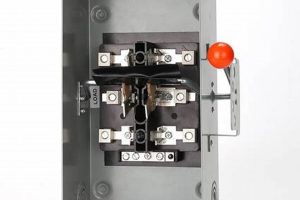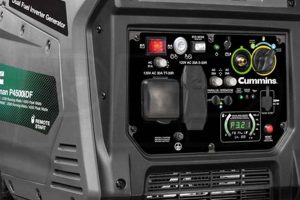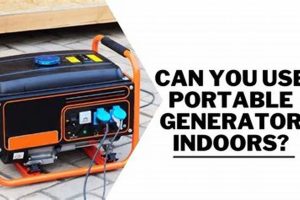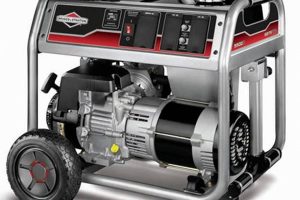A transfer switch isolates a structure’s electrical system from the utility power grid and connects it to a backup power source, such as a portable generator. Operating these switches by hand ensures a clear and deliberate action, preventing unintentional backfeeding of power onto the grid, a dangerous situation for utility workers. A typical setup involves connecting the generator to the switch’s input terminals and selected circuits within the building to its output terminals. Activating the switch then energizes these circuits with power from the generator.
Safeguarding a building against power outages is critical for maintaining essential functions and protecting sensitive equipment. These devices provide a reliable means of switching between utility and generator power, preventing damage to appliances and ensuring continued operation of crucial systems during blackouts. Historically, generator use often involved risky direct connections, leading to safety concerns and potential harm. The advent of transfer switches addressed these issues, offering a safer and more organized power management solution.
This discussion will further explore the various types of transfer switches available, the process of selecting and installing the correct switch for a particular application, and the necessary safety procedures to follow when utilizing a standby generator. Understanding these aspects is crucial for maximizing the benefits of a backup power system and ensuring its safe and effective operation.
Tips for Using Manual Transfer Switches with Portable Generators
Safe and effective operation of portable generators with manual transfer switches requires careful planning and adherence to established procedures. The following tips outline critical considerations for maximizing the benefits of a backup power system.
Tip 1: Professional Installation is Crucial: Incorrect wiring can lead to dangerous backfeeding and equipment damage. Consulting a qualified electrician for installation ensures compliance with electrical codes and safety standards.
Tip 2: Proper Generator Sizing: Select a generator with sufficient wattage to power the intended circuits. Overloading the generator can damage both the generator and connected appliances. An electrician can help calculate the necessary generator capacity.
Tip 3: Regular Maintenance: Periodically inspect the transfer switch for signs of wear or damage. Test the system by running the generator and switching between utility and generator power. Routine maintenance ensures reliable operation during outages.
Tip 4: Safe Operation Procedures: Before operating the generator, disconnect the main utility power supply. After the generator reaches a stable operating condition, activate the transfer switch to energize the selected circuits. Reverse this process when utility power is restored.
Tip 5: Understanding Load Management: Prioritize essential circuits and appliances. Avoid overloading the generator by staggering the use of high-wattage devices. Creating a load management plan prevents exceeding the generator’s capacity.
Tip 6: Proper Grounding: Ensure the generator and transfer switch are properly grounded to prevent electrical shock hazards. Consult the generator and transfer switch manuals for specific grounding instructions.
Tip 7: Carbon Monoxide Safety: Operate the generator outdoors in a well-ventilated area, away from doors, windows, and vents. Carbon monoxide poisoning is a serious hazard. Install carbon monoxide detectors near sleeping areas.
Adhering to these guidelines ensures the safe and efficient use of portable generators with manual transfer switches, providing reliable backup power during outages and protecting both equipment and individuals from potential hazards. These practices contribute to a robust and dependable emergency power solution.
These operational tips provide a foundation for understanding the safe and effective utilization of manual transfer switches with portable generators. The following section will conclude with a summary of key takeaways and emphasize the importance of responsible generator operation.
1. Safety
Safe operation of portable generators requires a thorough understanding of the inherent risks and the implementation of appropriate safety measures. Manual transfer switches play a crucial role in mitigating these risks, particularly preventing backfeeding, which can endanger utility line workers. Neglecting safety protocols can lead to severe consequences, including electrocution, fires, and equipment damage.
- Backfeeding Prevention
Backfeeding occurs when electricity from a generator flows back into the utility grid. This poses a lethal threat to utility workers repairing downed lines. Manual transfer switches physically isolate the home’s electrical system from the grid during generator operation, eliminating the possibility of backfeeding. A clearly labeled switch and established operating procedures further minimize the risk of accidental backfeeding.
- Electrocution Prevention
Improper grounding and incorrect wiring can create electrocution hazards. Professional installation of manual transfer switches ensures proper grounding and secure connections, minimizing the risk of shock. Using insulated cables and maintaining dry operating conditions further enhance electrical safety.
- Fire Hazard Mitigation
Overloading circuits and improper generator placement can cause fires. Manual transfer switches allow for selecting specific circuits for generator power, preventing overload. Locating the generator outdoors, away from flammable materials, and ensuring adequate ventilation further reduces fire risks.
- Carbon Monoxide Poisoning Prevention
Generators produce carbon monoxide, a colorless, odorless, and poisonous gas. Operating the generator in a well-ventilated area, away from doors, windows, and air intakes, is crucial. Installing carbon monoxide detectors provides an additional layer of protection against this silent killer.
Careful consideration of these safety aspects and adherence to proper operating procedures are essential for utilizing portable generators with manual transfer switches. Integrating these safety measures contributes significantly to a secure and reliable backup power solution, protecting both individuals and property.
2. Installation
Proper installation is paramount for the safe and effective operation of manual transfer switches for portable generators. Incorrect installation can lead to dangerous backfeeding, equipment damage, and ineffective power delivery during outages. Understanding the key facets of installation ensures a reliable and secure backup power solution.
- Location Selection
Transfer switch placement influences accessibility, wiring complexity, and environmental protection. Installing the switch near the main electrical panel minimizes wiring runs and simplifies operation. A dry, protected location safeguards the switch from weather and physical damage. For example, a garage wall near the electrical panel offers a practical and protected installation point. Careful location selection contributes significantly to long-term reliability and safety.
- Wiring and Connections
Accurate wiring is crucial for preventing hazards and ensuring proper functionality. Connecting the generator input to the designated terminals on the transfer switch and the selected circuits to the corresponding output terminals is essential. Using appropriately sized wiring and conduit protects against overheating and ensures efficient power delivery. For instance, using 10-gauge wire for a 30-amp circuit ensures safe current carrying capacity. Meticulous wiring practices are fundamental to a safe and dependable installation.
- Grounding and Bonding
Proper grounding and bonding are critical for electrical safety. Connecting the transfer switch and generator to a grounding rod or electrode provides a path for fault currents, preventing electrical shock. Bonding all metallic components of the system creates an equipotential plane, further mitigating shock hazards. This grounding system protects individuals and equipment from potentially dangerous electrical faults. Overlooking these aspects can compromise safety and create significant risks.
- Professional Expertise
Given the complexities and potential hazards associated with electrical work, professional installation is strongly recommended. Qualified electricians possess the knowledge and experience to ensure compliance with local electrical codes, proper wiring practices, and safe integration with the existing electrical system. Their expertise minimizes risks and ensures a reliable and code-compliant installation. Attempting DIY installation without adequate knowledge can lead to serious safety hazards and costly repairs.
These installation considerations are integral to the successful implementation of a manual transfer switch for a portable generator. Correct installation ensures the system’s safety, reliability, and effectiveness, providing a dependable backup power source during outages. Neglecting these aspects can compromise the entire system, creating potential hazards and jeopardizing the functionality of the backup power solution.
3. Operation
Operating a manual transfer switch correctly is crucial for safe and effective use of a portable generator during a power outage. The process involves a deliberate sequence of steps to ensure the safety of individuals and the proper functioning of the electrical system. Understanding this sequence and adhering to established procedures prevents hazards such as backfeeding and equipment damage. Incorrect operation can negate the safety features of the transfer switch and create dangerous situations.
The operation typically begins by disconnecting the main power supply from the utility grid. This isolates the home’s electrical system from the external power lines, preventing backfeeding during generator operation. Next, the portable generator is started and allowed to reach a stable operating condition. Once the generator is running smoothly, the manual transfer switch is activated. This physically connects the generator to the pre-selected circuits within the home. Power from the generator then flows through the transfer switch to these circuits, providing electricity during the outage. For example, a homeowner might connect essential circuits like refrigerators, lighting, and heating systems to the transfer switch, ensuring continued operation during a power disruption. When utility power is restored, the process is reversed. The transfer switch is deactivated, disconnecting the generator and reconnecting the home to the utility grid. The generator is then allowed to cool down before being shut off. This controlled sequence ensures a safe and seamless transition between power sources.
Understanding the operational sequence of a manual transfer switch is fundamental to maximizing the benefits of a portable generator during power outages. Correct operation ensures the safety of utility workers, protects electrical equipment, and provides a reliable source of power during emergencies. Neglecting proper procedures can create significant risks and compromise the functionality of the backup power system. This understanding empowers individuals to utilize portable generators effectively and safely, minimizing potential hazards and maximizing the benefits of backup power.
4. Capacity
Capacity, concerning manual transfer switches for portable generators, denotes the maximum electrical load the switch can safely handle. This rating, expressed in amperes, dictates the total power draw permissible from the generator through the switch. Appropriate capacity selection is crucial; an undersized switch risks overheating and potential fire hazards due to exceeding its current-carrying limits. Conversely, an oversized switch represents unnecessary expense. A critical aspect of capacity determination involves calculating the combined wattage of the circuits intended for generator power. For example, a homeowner wishing to power a refrigerator (1500 watts), a furnace blower (1000 watts), and several lights (500 watts) requires a transfer switch and generator capable of handling at least 3000 watts, or approximately 25 amps at 120 volts. This careful capacity planning ensures the safe and effective operation of the backup power system.
Transfer switch capacity directly influences generator selection. The generator’s output must align with the switch’s capacity; a generator exceeding the switch’s rating creates a potential overload scenario. Consider a 7500-watt generator connected to a 30-amp transfer switch. While the generator possesses ample power, the switch limits the safe usable power to approximately 3600 watts at 120 volts. Understanding this interplay between generator output and switch capacity is essential for avoiding equipment damage and maximizing system efficiency. Furthermore, load management plays a vital role in operating within capacity limits. Prioritizing essential circuits and staggering the use of high-wattage appliances prevents exceeding the switch’s capacity, ensuring safe and continuous operation during outages.
Accurate capacity assessment is fundamental to a safe and functional backup power system. Careful consideration of intended loads, coupled with an understanding of the relationship between generator output and transfer switch capacity, ensures efficient and reliable operation during power disruptions. Ignoring capacity limitations compromises safety and risks equipment damage, undermining the purpose of the backup power solution. A thorough understanding of these principles empowers informed decisions, leading to a robust and dependable system capable of meeting power needs during emergencies.
5. Types
Various types of manual transfer switches exist, each designed for specific applications and generator configurations. Selecting the correct type is crucial for compatibility, safety, and effective power management during outages. Understanding the distinctions between these types empowers informed decisions aligned with specific power requirements and budgetary constraints.
- Open Transition Transfer Switches
Open transition switches briefly interrupt power during the transfer process. This break-before-make mechanism ensures complete isolation between the utility grid and the generator, enhancing safety and preventing backfeeding. While suitable for most residential applications, the momentary power interruption may not be ideal for sensitive electronic equipment. This type often represents a more cost-effective solution for basic backup power needs.
- Closed Transition Transfer Switches
Closed transition switches utilize a make-before-break mechanism, allowing a brief overlap where both the utility and generator power the circuits. This seamless transition eliminates power interruptions, making them suitable for sensitive electronics and critical systems. However, this type generally comes at a higher cost and requires more complex installation. This design minimizes downtime for sensitive equipment but introduces the potential for backfeeding if not installed and operated correctly.
- Three-Position Transfer Switches
Three-position switches offer a third setting beyond the standard “Line” and “Generator” positions. This additional “Off” position completely isolates the electrical system from both power sources, facilitating maintenance and enhancing safety during certain operations. While providing flexibility, this type adds complexity and may require more specific wiring configurations. This feature allows for system isolation during maintenance or emergencies.
- Service Entrance Rated Transfer Switches
Service entrance rated switches integrate the transfer switch functionality into the main service disconnect, simplifying installation and reducing the need for additional wiring. These switches often incorporate overcurrent protection and serve as the primary disconnect for the entire electrical system. While offering a streamlined solution, they typically come at a higher cost and may require more extensive electrical work during installation. This integrated approach offers a comprehensive solution for both utility and generator power management.
Careful consideration of these distinct types, alongside specific power requirements and budget, ensures the selection of the most appropriate manual transfer switch for a given application. Understanding the nuances of each type, such as transition methods and integrated features, empowers informed decisions and contributes to a safe, reliable, and effective backup power solution. This knowledge guides the selection process, ensuring the chosen switch aligns with the overall power strategy and minimizes potential issues during installation and operation.
6. Cost
Cost represents a significant factor when considering manual transfer switches for portable generators. Several variables influence the overall expense, including the switch’s amperage rating, type, features, and brand. Higher amperage ratings generally correlate with higher prices, reflecting the switch’s capacity to handle greater electrical loads. For instance, a 100-amp transfer switch typically costs more than a 30-amp switch due to its ability to manage a larger power demand. Switch type also impacts cost; closed-transition switches, offering seamless power transfer, generally command higher prices than open-transition switches due to their more complex internal mechanisms. Additional features, such as integrated surge protection or load shedding capabilities, further influence cost, adding to the overall investment.
Installation costs contribute significantly to the total expenditure. Professional installation by a qualified electrician is strongly recommended for safety and code compliance. Installation complexity varies depending on the existing electrical system and the chosen switch type. Factors such as wiring runs, panel modifications, and additional materials influence labor costs. For example, installing a service entrance rated transfer switch typically involves more extensive electrical work than installing a standard transfer switch, resulting in higher installation fees. Obtaining multiple quotes from qualified electricians allows for cost comparison and informed decision-making.
Understanding the cost components associated with manual transfer switches empowers informed purchasing decisions. Balancing budget constraints with desired features and capacity requirements necessitates careful evaluation of available options. While cost remains a significant consideration, prioritizing safety and functionality ensures a reliable and effective backup power solution. Investing in a properly sized and installed transfer switch ultimately mitigates potential risks and provides peace of mind during power outages. Neglecting these considerations based solely on price can compromise safety and jeopardize the long-term performance of the backup power system. A comprehensive cost analysis, considering both equipment and installation expenses, contributes to a sound investment that meets both budgetary and functional needs.
7. Maintenance
Maintaining manual transfer switches for portable generators is crucial for ensuring their reliable operation during power outages. Neglecting maintenance can lead to malfunctions, safety hazards, and ultimately, failure to provide backup power when needed. A well-maintained transfer switch contributes significantly to the longevity and dependability of the entire backup power system.
- Visual Inspection
Regular visual inspections are essential for identifying signs of wear, damage, or loose connections. Inspecting the switch for signs of corrosion, overheating, or physical damage can prevent potential failures. For instance, a loose wire could cause overheating or arcing, leading to a malfunction. These inspections should include checking the wiring connections, the switch mechanism itself, and the enclosure for any signs of deterioration. Thorough visual inspections are the first line of defense in preventative maintenance.
- Operational Testing
Periodically testing the transfer switch simulates real-world operation, confirming its functionality under load. This involves running the generator and transferring power to the designated circuits to verify correct operation. For example, testing the switch monthly ensures it functions correctly when needed during an outage. This process verifies the switch’s ability to transfer power smoothly and reliably. Regular operational tests identify potential issues before they escalate into critical failures during an actual outage.
- Cleaning and Lubrication
Keeping the transfer switch clean and properly lubricated ensures smooth operation and prevents mechanical issues. Removing dust and debris prevents buildup that can interfere with the switch mechanism. Lubricating moving parts, as recommended by the manufacturer, reduces friction and wear. For example, applying electrical contact cleaner to the switch contacts annually can prevent corrosion and ensure reliable connections. These simple maintenance tasks contribute significantly to the switch’s longevity and dependable performance.
- Professional Servicing
While routine maintenance can be performed by homeowners, periodic professional servicing is recommended for more thorough inspections and complex repairs. Qualified electricians possess the expertise to identify potential issues, replace worn components, and ensure the switch adheres to safety standards. For instance, a professional can test the switch’s internal components and identify potential problems that may not be apparent during visual inspections. Professional servicing provides an additional layer of assurance, guaranteeing the transfer switch’s continued safe and reliable operation.
These maintenance practices are fundamental to ensuring the long-term reliability and safety of manual transfer switches. Regular maintenance minimizes the risk of malfunctions during power outages, protects connected equipment, and extends the lifespan of the transfer switch. A proactive approach to maintenance safeguards the investment in the backup power system and provides peace of mind during emergencies. Failing to prioritize maintenance can lead to costly repairs, safety hazards, and ultimately, the failure of the backup power system when it’s needed most. Consistent and thorough maintenance practices are an essential component of a robust and dependable backup power solution.
Frequently Asked Questions
This section addresses common inquiries regarding manual transfer switches for portable generators, providing clear and concise information to facilitate informed decision-making.
Question 1: What is the primary function of a manual transfer switch?
A manual transfer switch safely connects a portable generator to a building’s electrical system while simultaneously isolating it from the utility power grid. This prevents backfeeding, a dangerous phenomenon that can harm utility workers.
Question 2: Is professional installation necessary for a manual transfer switch?
Professional installation by a qualified electrician is strongly recommended. Incorrect wiring can lead to safety hazards, equipment damage, and code violations. Professional installation ensures compliance with electrical codes and best practices.
Question 3: How does one determine the appropriate size transfer switch for a specific application?
Calculating the total wattage of the circuits intended for generator power determines the necessary switch capacity. Consulting an electrician assists in accurately assessing power requirements and selecting a suitably sized switch.
Question 4: What are the key differences between open and closed transition transfer switches?
Open transition switches briefly interrupt power during the transfer process, while closed transition switches provide a seamless, uninterrupted transition. Closed transition switches are preferable for sensitive electronic equipment but typically cost more.
Question 5: What safety precautions are essential when operating a portable generator with a manual transfer switch?
Operating the generator outdoors in a well-ventilated area is crucial to prevent carbon monoxide poisoning. Disconnecting the main utility breaker before activating the transfer switch prevents backfeeding. Adhering to manufacturer guidelines ensures safe operation.
Question 6: How often should a manual transfer switch be maintained?
Regular visual inspections and periodic operational tests are recommended. Visual inspections should occur monthly, while operational tests, involving running the generator and transferring power, should be conducted every few months or as needed to ensure functionality.
Understanding these key aspects of manual transfer switches empowers informed decisions regarding backup power solutions. Careful consideration of these factors ensures the safe and effective operation of portable generators during power outages.
For further information and specific guidance, consult qualified electricians and refer to manufacturer documentation.
Manual Transfer Switches for Portable Generators
Manual transfer switches represent a crucial component of safe and effective portable generator usage. This exploration has highlighted their essential role in preventing backfeeding, ensuring operator safety, and facilitating reliable power delivery during outages. Proper switch selection, professional installation, and adherence to safe operating procedures are critical for maximizing the benefits of backup power. Understanding capacity requirements, choosing the appropriate switch type, and maintaining the equipment are essential for long-term reliability. Ignoring these factors can compromise safety and jeopardize the functionality of the backup power system.
Reliable backup power is paramount in today’s interconnected world. Investing in a robust system, including a properly sized and installed manual transfer switch, provides peace of mind and safeguards against the disruptive impacts of power outages. Informed decision-making and proactive maintenance practices ensure a dependable backup power solution capable of meeting critical needs during emergencies. Preparation and responsible operation are key to harnessing the full potential of portable generators and mitigating the risks associated with power disruptions.






